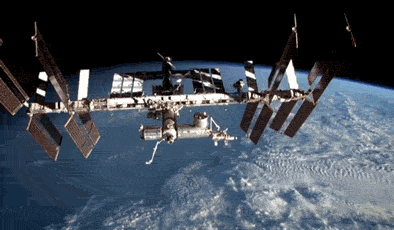ISS — Expedition 59 Mission patch.
June 5, 2019
The International Space Station residents continued exploring today what living off the Earth for long periods is doing to their body. The Expedition 59 crew also researched ways to improve life in space and even filmed a virtual experience aboard the orbiting lab.
NASA astronauts Nick Hague and Christina Koch took turns serving as Crew Medical Officer during a round of ultrasound eye exams Wednesday morning. The duo scanned the eyes of Commander Oleg Kononenko and Flight Engineers Anne McClain and David Saint-Jacques ahead of their homecoming June 24. Astronauts have reported vision issues during and after their missions. The eye imaging helps doctors understand how microgravity impacts the cornea, lens, optic nerve and the shape of the eyeball.
Image above: The six-member Expedition 59 crew gathers for a portrait inside of the vestibule between the SpaceX Dragon cargo craft and the Harmony module the day before the commercial space freighter’s departure. Image Credit: NASA.
Saint-Jacques once again had his blood pressure checked and arteries scanned with an ultrasound device to investigate how weightlessness affects the cardiovascular system. Arterial stiffness has been observed in space and the study may help offset the negative effects improving life in space and on Earth. The astronaut from the Canadian Space Agency also recorded a virtual reality video of his biomedical activities for later viewing on Earth.
McClain monitored a small cube-shaped robot called the Astrobee and tested its ability to float around the Kibo laboratory module autonomously. Engineers are assessing the free-flying device’s potential to perform routine maintenance duties and provide additional lab monitoring capabilities.
Koch wrapped up the day in Europe’s Columbus laboratory module setting up a fluid physics study that has been observing sloshing and waves on the station since 2016. The Fluidics study uses a motorized instrument to slosh fluids in tanks with video and data downlinked to researchers on the ground. Results could optimize the design of satellite fuel systems and increase the understanding of Earth’s oceans and climate.
Related links:
Expedition 59: https://www.nasa.gov/mission_pages/station/expeditions/expedition59/index.html
Cardiovascular system: https://www.nasa.gov/mission_pages/station/research/experiments/explorer/Investigation.html?#id=1664
Virtual reality video: https://www.nasa.gov/mission_pages/station/research/experiments/explorer/Investigation.html?#id=7877
Astrobee: https://www.nasa.gov/mission_pages/station/research/experiments/explorer/Facility.html?#id=1891
Kibo laboratory module: https://www.nasa.gov/mission_pages/station/structure/elements/japan-kibo-laboratory
Columbus laboratory module: https://www.nasa.gov/mission_pages/station/structure/elements/europe-columbus-laboratory
Fluidics: https://www.nasa.gov/mission_pages/station/research/experiments/explorer/Investigation.html?#id=2043
Space Station Research and Technology: https://www.nasa.gov/mission_pages/station/research/index.html
International Space Station (ISS): https://www.nasa.gov/mission_pages/station/main/index.html
Image (mentioned), Animation (mentioned), Text, Credits: NASA/Mark Garcia.
Best regards, Orbiter.chArchive link








Комментариев нет:
Отправить комментарий